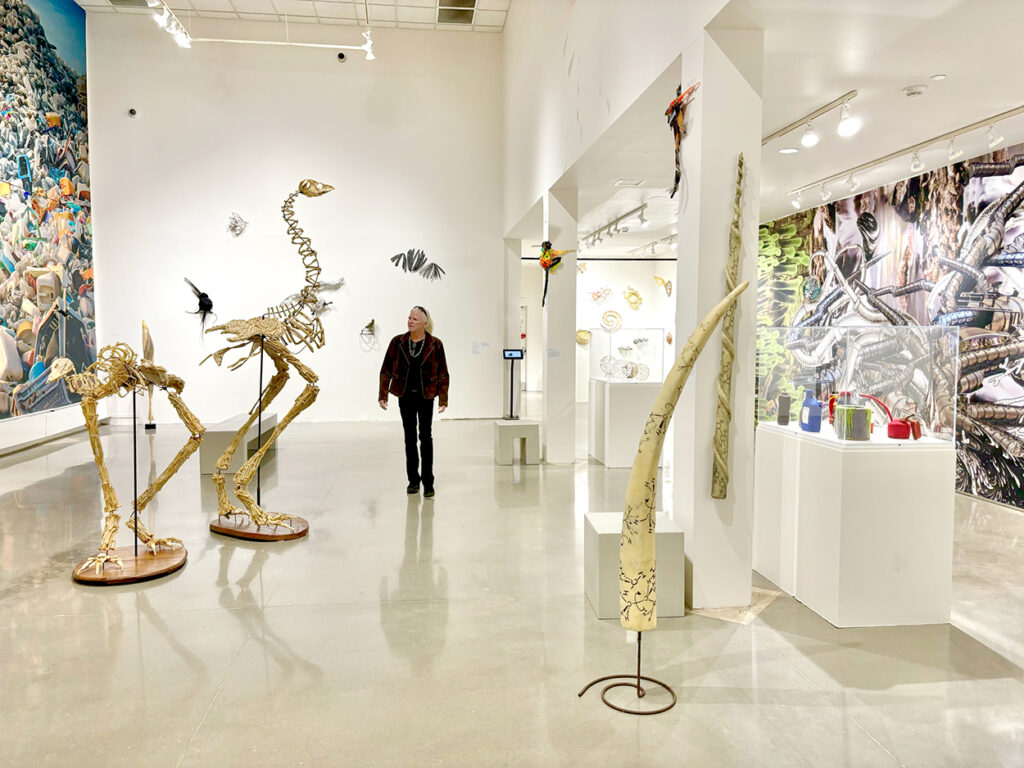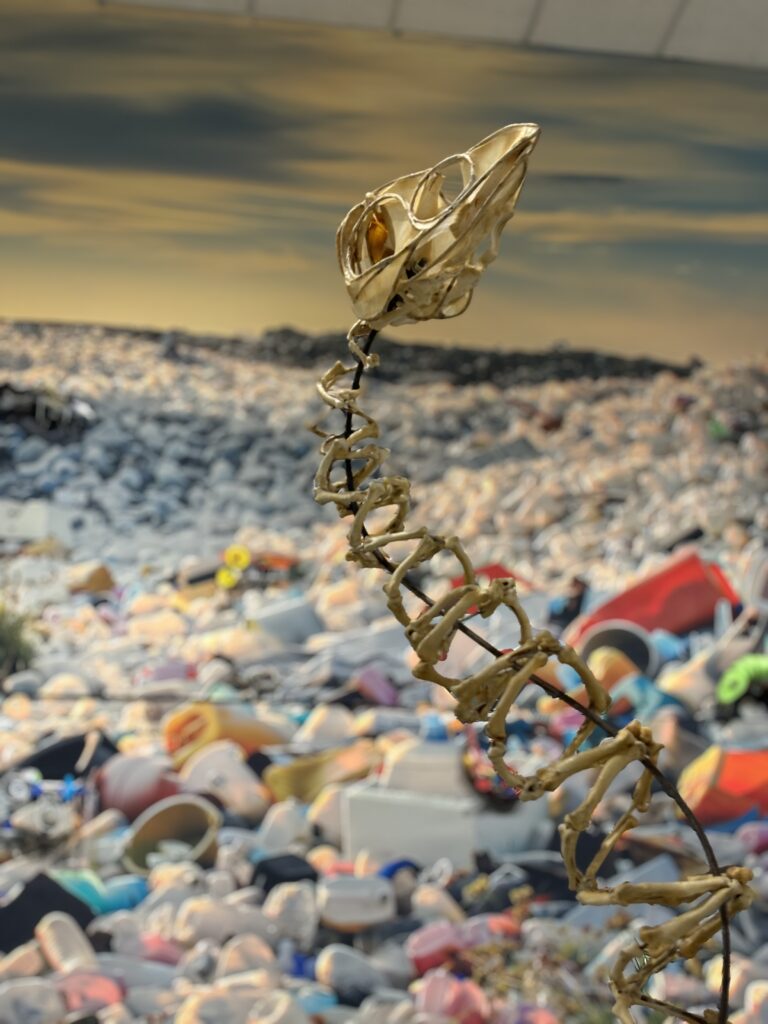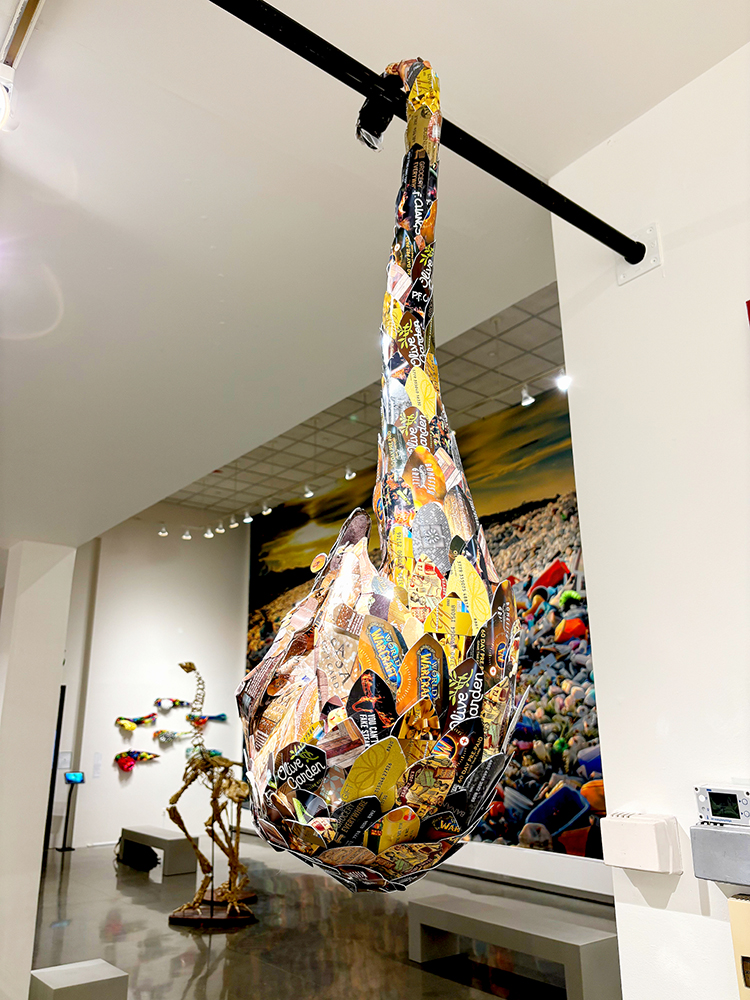by Jen Dragon

Since the ’70s, Christy Rupp’s sculptures and works on paper have explored the relationship between economics and the environment. Rupp seeks to make this complex topic – one usually examined in abstract articles – into a clear and direct visual narrative accessible beyond the language of dissertations, punditry, and scientific studies. Emerging from the lens of Discard Studies, a discipline that considers the systems and consequences of waste, Rupp weighs these systems and their short-term benefits against the long-term costs of climate degradation and the marginalization of threatened species.
Buried in history, politics, and culture, the politics of waste are rooted in consumerism with its voracious consumption and energy needs. Christy Rupp dives into this dystopia with welded steel, foraged plastic detritus, historical, scientific, and contemporary imagery, a dark sense of humor, and the uncanny ability to connect the dots. Her artwork charts a course through the turmoil, observing the trail of collateral damage as it moves through our world, seeking to interpret and magnify these interdependencies.

Some examples of Rupp’s visual unification of cause and effect are found in her installation Moby Debris, a collection of microplanktonic organisms made from welded steel rods and discarded plastic. To quote artist and art scholar Ellen K. Levy, “Rupp considers how waste and toxic elements in our environment corrupt the accepted way in which organisms function and evolve…Each of her aquatic-inspired “organisms” is composed of discarded plastic detritus and visually comments on the damage done to species when they consume the glut of inorganic detritus hurled into our food chain.” In magnifying the petroplanktonic microbes that inevitably find their way into a whale’s stomach, Rupp clarifies the irony of a food chain where the smallest organisms sustain the largest mammals along with the floating oceanic plastic waste that accompanies them into a whale’s stomach. A similar statement is made with the plastic-stuffed wall works of Aquatic Larvae, with the paradox of young hatchling fishes nurtured in egg sacks populated by a buffet of accumulated microplastics.

In works such as her Pangolins and the series Remaining Balance Insufficient featuring aquatic mammal skeletons, Rupp bends and welds steel rods into graceful lines as effortlessly as if drawn on paper. The animals’ forms are then sheathed in innumerable, shimmering credit cards as they float jewel-like in the air. However, these pangolins and manatees are victims of environmental exploitation as they wrestle with human-caused habitat degradation. Rupp’s visualization of their plight equates the debt incurred with their survival, leveraged against the temporary advantage of human exploitation. Made as they are of credit cards, this work reminds us that, unlike the world of finance, the biosphere is not man-made, and it’s impossible to manipulate with numbers and percentages. Natural habitat is much easier to destroy than repair.
In addition to numerous sculptures, the exhibition features two giant digital prints on fabric that confront the emergency of non-renewable energy and plastic waste and their enduring damage to terrestrial systems. While these immense banners cannot ever be large enough to fully present this unfolding catastrophe, an abstract appreciation for the beauty of materials out of place is obvious.
As much as Christy Rupp’s art is about ecological emergencies, she is informative without being didactic, while her playful wit and whimsical spirit convey the darkest news. However, her direct and accessible message does not come at the expense of aesthetics as the artist’s accomplished draftsmanship and percussive colors are at once delightful and dramatic. In visualizing the effects of ecological degradation, Christy Rupp does not pinpoint any single culprit – only because there isn’t just one cause; rather, there is a collective complacency that permeates society. Anyone who views Rupp’s work is engaged in some way as a citizen of a world in which it is easier to participate in a petrochemical-fueled lifestyle, blissfully ignorant of our burgeoning carbon footprint and impending doom.
